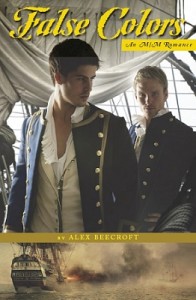Cover Art: The ubiquitous torso revealed!
Cover art is one of the things that unites writers of m/m fiction (in so far as we can be united at all). We all hope to have a cover that reflects the story we’ve written. We’d like to have something different, maybe sexy, maybe moody, something tasteful that we won’t feel ashamed about reading in public. If we’re historical authors we’d really like our book covers to reflect that. Maybe it would be nice to have our characters in the appropriate clothing for the time, en déshabillé, their poet-shirts undone and their cravats scattered across the bedroom floor.
It would be perfect to have something like this:
For example, and we wonder why some publishers can manage to do it, when most of our publishers give us variations on something like this:
Recently, as a sideline and a way of making sure that I got a cover for my books which I liked myself, I started making cover art. I naively thought that I would be able to produce covers like the one for False Colors for all my books. What I learned instead was that that was simply not possible given the resources I had on hand.
The chief difficulty that faces a cover artist who cannot themselves draw or paint – someone who is dependant on being able to combine two or more photos with their mad photoshopping skillz – is finding the photos to use as your raw material.
Although the internet is full of beautiful photos, you can’t just google “men in period costume” and use the best photo you find. Do you know where that photo came from? Do you know who owns it? Who has copyright? Will they allow you to use the photo on the front of a gay romance? If they see their photo on the front of a gay romance, will they sue you? You really don’t want to run that risk.
To answer all these questions and to keep yourself safe from the threat of legal action against you, you can’t just pick up photos wherever you find them.
So you go to a stock-photo site, where you know you can buy the photos, with a licence to use them on book covers, and a model release from the person in the photograph, so you know he won’t sue you later.
But now you’re paying for your photos, economic reality sets in. How much is a small press publisher prepared to pay for the cover art of a single book?
Because most small press publishers have an in-house artist, who is able to buy photos in bulk and thereby get economies of scale, you’re going to have to compete with a rate of about $50 per cover.
That sounds quite a lot until you start looking for photos. This is a nice one, for example. You could make something good out of that, with a second photo for a background.
But this one costs $450 at high resolution (and you need high resolution for book covers – you don’t want things to look pixellated.) So that’s right out.
The same goes for most classical paintings. I wanted to make a give-away dust-cover for Captain’s Surrender out of a painting of Captain Alexander Hood, which would have looked like this:
But the picture cost over $1000 to licence, and that’s the case with most famous (and not so famous) paintings, so I abandoned that idea.
On a budget of $50, clearly that kind of cover is impossible to make. So what does that leave us with?
Well, it leaves us with photos from some of the cheaper stock photo sites. These are the ones I know of which are affordable
with photos that range from $3 – £8 a go, you can afford to buy two or even three photos to composite into a single image, and still have a tiny bit of profit to pay for the hours you spend working on the cover.
But because you’re confined to finding photos you can legally use and afford, your horizons have already shrunk. And, to be frank, if you’re looking for anything other than contemporary photos, you’re going to be disappointed. There are a few generic photos of reenactors on the stock photo sites, but reenactors as a whole are not sex-gods – they tend to be middle aged beardy men who are not likely to set hearts aflutter. Good luck to you if you want to find young, handsome men in period costume! I’d like to know how you did it!
This is why it’s easier for the big publishers like Running Press to get an artist who will set up a photo-shoot, bring in models and appropriate costumes and take their own photos. Which is how the covers of False Colors and Transgressions get to be so awesome. But, again, you need the budget for it.
OK, you may think, “so find a picture of a handsome man and photoshop a period costume onto him.”
Well
(a) where are you going to find your picture of a period costume to use?
(b) and perhaps this is just me, but I think you can always tell. I’ve seen enough covers with dodgy light sources, people with obvious white lines around them where they’ve been cut out of a different background, people whose heds are pastede on, people whose hair is pastede on etc etc that that is something I would only do if there was no other choice. The human eye is very good at picking this stuff up, and do you really want your book cover to look like a bad manip?
Of course, you might say “but I don’t mind it looking like a good manip! A good photoshopper can make a manip which fools the eye!”
Well… this is true. But do you know how long that takes? And are you expecting the publisher to pay the cover artist to spend all the long hours it takes to get it right at an hourly wage? Or are you expecting the cover artist to do all that work for free?
OK, you may think, “so take the beefcake off the front altogether and just use a historical type background, like the cover of Standish.”
Well, I’m all for that!
The trouble is that market research indicates that covers with people on them sell more than covers without, and sexy covers with people on them sell more than non-sexy covers.
I have my doubts about the market research, because nobody can say that Standish doesn’t sell better than masses of mass produced man-titty covers. But my doubt doesn’t have a lot of persuasive power.
Publishers (and writers) want their books to sell. Market research indicates you get more sales with a person on the cover, and preferably a sexy one. So what can you do?
Well, we’ve already established that there are no cheap pictures of attractive men in period costume. We’ve argued that photoshopping period costume onto attractive men has major difficulties too. You can’t put men in modern clothes onto a historical cover… What’s left?
What’s left is the ubiquitous naked torso. We can assume that men with no clothes on in the 18th Century or the 9th Century looked very much like men with no clothes on in the 21st Century. And this has the advantage that stock photo sites are full of pictures of bare-chested men. They’re usually wearing modern trousers, so you cut their legs off, and they’re often wrong in the face or hairstyle for the character in the book, so you cut their heads off too. Problem solved 😉






Interesting discussion, Alex. Regarding 21st century naked men looking like 18th century naked men…I think there are differences. I think people now tend to be fitter, more muscular, and taller. I am not sure their physiques are the same.
Just the other day I heard an interview with Ang Lee about his new movie, Taking Woodstock. He said the hardest thing was casting enough hippies, especially for the naked scenes. Why? In the 1960s, people were hairier than they are now…men didn't shave or wax their chests, shoulders, and backs; men and women didn't shave/trim their pubic hair, and so on. Apparently, Lee had a hard time finding enough unshaven folks to cast as naked hippies in the movie. LOL.
Leslie
Interesting discussion, Alex. Regarding 21st century naked men looking like 18th century naked men…I think there are differences. I think people now tend to be fitter, more muscular, and taller. I am not sure their physiques are the same.
I heard an interesting interview with Ang Lee about his new movie Taking Woodstock. The hardest people to cast were the extras to play hippies, especially for the nude scenes. Why? No, it's not because people are shy. Apparently, in the 1960s, people are hairier than they are now. Men didn't shave or wax or their chests, shoulders and backs; men and women didn't trim their pubic hair. Lee had a hard time finding suitably hairy people to be in the movie. Who knew? LOL.
L
I think you're right that the physique wouldn't really be the same, and that's one of the reasons why I don't like the really obviously gym-conditioned bodies that a lot of publishers use. But 18th Century men walked everywhere, rode on horseback and fenced as a regular thing, so I don't think we can rule out the possibility that they had the kind of muscles that come with use and exercise. And as far as hair goes – well, we are talking romance, so a certain amount of fantasy is allowable, I think 🙂